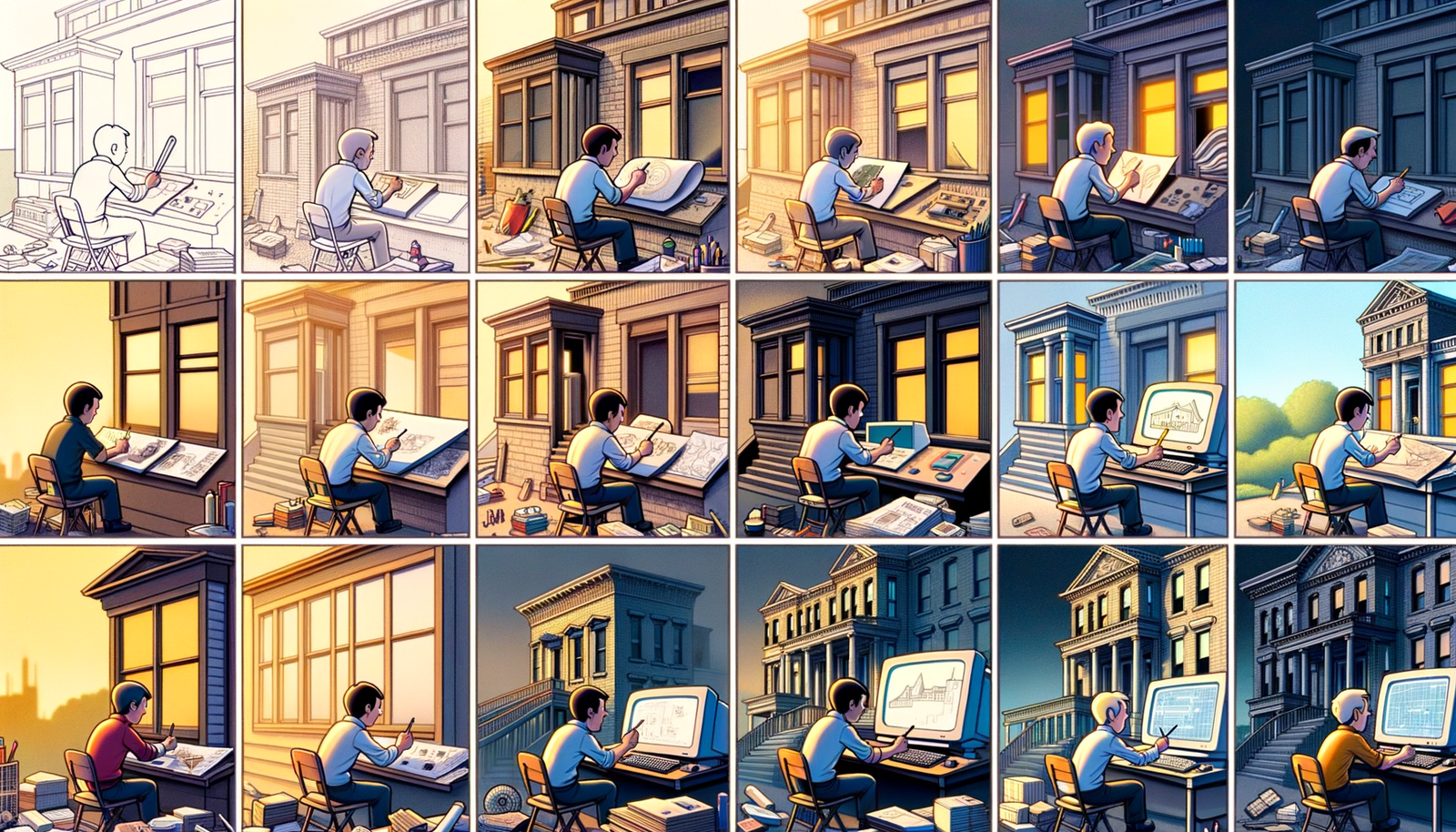Your Cart is Empty
Customer Testimonials
-
"Great customer service. The folks at Novedge were super helpful in navigating a somewhat complicated order including software upgrades and serial numbers in various stages of inactivity. They were friendly and helpful throughout the process.."
Ruben Ruckmark
"Quick & very helpful. We have been using Novedge for years and are very happy with their quick service when we need to make a purchase and excellent support resolving any issues."
Will Woodson
"Scott is the best. He reminds me about subscriptions dates, guides me in the correct direction for updates. He always responds promptly to me. He is literally the reason I continue to work with Novedge and will do so in the future."
Edward Mchugh
"Calvin Lok is “the man”. After my purchase of Sketchup 2021, he called me and provided step-by-step instructions to ease me through difficulties I was having with the setup of my new software."
Mike Borzage
Design Software History: The Evolution of Architectural Illustration: From Hand-Drawings to Digital Design Technologies
February 15, 2025 11 min read


The evolution of architectural illustration reflects a profound journey from the meticulous art of hand-drawing to the sophisticated digital tools of today. This transformation mirrors the broader advancements in technology and society's changing needs. Architectural illustration has always been more than mere depiction; it's an intricate language that communicates visions, persuades stakeholders, and brings architectural concepts to life. Understanding this evolution offers valuable insights into how architecture itself has progressed, blending creativity with technology to shape the environments we inhabit.
Historical Context
Architectural illustration traces its origins back to ancient civilizations, where drawings were essential for planning monumental structures like the pyramids of Egypt and the temples of Greece. These early illustrations were foundational in conveying complex ideas in an era without modern communication tools. As architecture evolved, so did the importance of illustrations; during the Middle Ages and Renaissance, drawings became crucial for sharing design concepts across different regions and cultures. The Renaissance, in particular, marked a significant advancement with architects like Filippo Brunelleschi and Leonardo da Vinci, who utilized perspective drawing to represent three-dimensional structures on two-dimensional surfaces accurately.
The artisanal craftsmanship of hand-drawn architectural illustrations was not only a technical necessity but also a respected art form. Architects and illustrators spent years honing their skills, mastering techniques that required a keen eye and a steady hand. Tools were simple yet effective: ink pens, graphite pencils, and various types of paper facilitated detailed and precise work. The lack of modern technology meant that every line drawn was deliberate, and mistakes could be costly. These illustrations were as much about the process as they were about the final product, embodying the dedication and expertise of their creators.
In addition to being practical tools for construction, these illustrations served as persuasive presentations to patrons and the public. They were essential in an era when literacy was not widespread, and visual representations were the most effective means of communication. The ability to illustrate buildings with realistic detail helped architects win commissions and influenced the architectural styles that defined different periods. Thus, traditional hand-drawing was integral to both the practical and cultural development of architecture.
Influence of Key Architects and Illustrators
Frank Lloyd Wright, one of the most prominent architects of the 20th century, exemplified the power of hand-drawn illustrations in shaping architectural thought. His drawings were renowned for their clarity, innovation, and artistic quality. Wright's use of bold lines and geometric forms conveyed his philosophy of organic architecture, which sought harmony between human dwellings and the natural world. His illustrations often included intricate details and a unique perspective that highlighted the relationship between the building and its environment. Wright's work demonstrated how illustrations could encapsulate complex ideas and set new directions in architectural design.
Hugh Ferriss, another influential figure, revolutionized architectural visualization with his dramatic and atmospheric renderings. In the 1920s and 1930s, Ferriss's illustrations of skyscrapers in New York City captured the imagination of architects and the public alike. Using heavy shading and towering perspectives, he depicted buildings that soared into the clouds, symbolizing the optimism and ambition of the era. His work influenced zoning laws and urban planning, as his visionary illustrations showed both the potential and the challenges of high-density urban development. Ferriss's techniques added emotional depth to architectural illustration, making it a tool not just for representation but for inspiration.
These pioneers were instrumental in elevating architectural illustration from a mere technical requirement to an expressive art form. Their contributions demonstrated that illustrations could convey more than just structural information; they could communicate vision, evoke emotions, and influence societal trends. The legacy of architects and illustrators like Wright and Ferriss is evident in how architectural drawings are still used today to inspire and persuade, proving that the essence of their artistry remains relevant despite technological advancements.
Techniques and Tools
The traditional era of architectural illustration relied heavily on specialized tools and meticulous techniques. Architects used a variety of pens, such as dip pens with interchangeable nibs, allowing for different line thicknesses and styles. The advent of the technical pen, like the Rapidograph introduced by Koh-I-Noor, provided consistent line widths essential for detailed work. Pencils ranging from soft graphite to hard leads were used for sketching and shading, offering versatility in texture and tone. Paper choice was equally important; high-quality papers like vellum or drafting film provided smooth surfaces that could withstand repeated erasing and redrawing.
Drafting equipment was central to the precision required in architectural drawings. Tools like the T-square ensured straight horizontal lines, while the adjustable triangle allowed for accurate angles. Compasses and dividers were used to draw circles and transfer measurements, crucial for maintaining scale and proportion. French curves and spline tools helped in drawing smooth, complex curves that were otherwise challenging to render by hand. The meticulous use of these tools reflected the discipline and exactness that architectural illustration demanded.
- Perspective Drawing: Mastery of one-point, two-point, and three-point perspectives was essential for creating realistic spatial representations. This skill allowed architects to depict how a building would appear from various viewpoints, aiding in both design and presentation.
- Shading and Rendering: Techniques such as hatching, cross-hatching, and stippling added depth and texture to drawings. These methods simulated light and shadow, giving two-dimensional illustrations a three-dimensional feel.
- Rendering Textures: Representing different materials like wood, stone, or glass required specific techniques to convey texture and reflectivity. This attention to detail helped clients and builders understand the intended use of materials.
The process of hand-drawing was iterative and required immense patience. Mistakes meant starting over or carefully correcting without compromising the integrity of the drawing. This meticulous approach fostered a deep understanding of the design, as architects engaged intimately with every aspect of their work. The traditional techniques and tools were not just means to an end but were integral to the creative process, shaping the way architects thought about and developed their designs.
Introduction to Computer-Aided Design
The 1960s marked the beginning of a technological revolution in architectural illustration with the introduction of computer-aided design (CAD). Ivan Sutherland's creation of Sketchpad in 1963 at MIT was a pivotal moment. Sketchpad was the first program to utilize a graphical user interface and allowed users to interact with the computer using a light pen to draw directly on the display. This innovation demonstrated the potential of computers to handle complex graphical computations, laying the groundwork for future CAD systems. Sketchpad was revolutionary, showing that computers could not only perform calculations but also assist in the creative aspects of design.
The transition from the late 1970s to the 1980s saw CAD technology becoming more accessible and practical for architectural applications. Companies like Autodesk, founded by John Walker in 1982, played a crucial role in this transformation. The release of AutoCAD in 1982 brought CAD software to a wider audience, offering capabilities that significantly enhanced drafting efficiency and precision. AutoCAD allowed architects to create, modify, and optimize designs with greater ease than ever before. The software's ability to store and manipulate large amounts of data meant that complex designs could be managed more effectively.
This period was characterized by rapid advancements in computing power and software capabilities. The incorporation of CAD into architectural practice began to reshape the industry, offering tools that could perform tasks previously unimaginable. CAD systems enabled architects to experiment with forms, test structural integrity, and visualize designs in new ways. The transition to digital design was not without challenges, but it heralded a new era where technology and creativity could converge more seamlessly.
Transformation in Architectural Workflows
CAD software revolutionized architectural drawing processes by introducing unprecedented levels of precision and efficiency. Programs like AutoCAD enabled architects to draft with exact measurements, reducing human error and enhancing the accuracy of construction documents. The ability to create and edit digital blueprints streamlined workflows, allowing for quicker revisions and iterations. Digital tools facilitated complex calculations and simulations, making it easier to test structural integrity and compliance with building codes.
The use of CAD expanded the possibilities for design complexity. Architects could now experiment with forms and structures that were difficult or impossible to represent accurately by hand. The software's capabilities in handling three-dimensional modeling allowed for more innovative and experimental designs. Features like layering and object grouping helped manage intricate projects by organizing elements logically. This not only improved the design process but also enhanced communication with engineers and contractors.
Moreover, CAD systems improved collaboration among project stakeholders. Digital files could be shared easily, and multiple team members could work on different aspects of a design simultaneously. This collaborative environment accelerated project timelines and facilitated better coordination. The integration of CAD into architectural practice marked a significant shift toward a more interconnected and dynamic approach to design and construction.
Industry Reactions and Adaptations
The adoption of CAD technology required significant adjustments within the architectural profession. Educational institutions began integrating CAD training into their curricula, recognizing the necessity for new graduates to be proficient with digital tools. This shift meant that aspiring architects needed to develop both traditional drawing skills and technological competencies. Established architects and firms faced the challenge of retraining staff and updating workflows to incorporate CAD effectively. The transition prompted a reevaluation of the skills deemed essential for architectural practice.
Reactions within the industry were mixed. While many embraced the efficiency and enhanced capabilities that CAD offered, others were resistant, valuing the artistry and tactile experience of hand-drawing. Some traditional illustrators viewed the rise of digital tools as a threat to the craftsmanship that defined their profession. However, over time, the benefits of CAD became undeniable, and most professionals adapted by blending traditional techniques with digital methods.
Companies that specialized in architectural illustration also had to evolve. Firms like Nemetschek, the developer of Vectorworks, and Bentley Systems, known for MicroStation, emerged to provide specialized software solutions. These companies contributed to the diversification of tools available to architects, catering to different aspects of design and documentation. The industry's adaptation to CAD technology was a complex process, but it ultimately led to a more versatile and innovative architectural landscape.
Advancements in Software and Tools
The turn of the 21st century brought about significant advancements in architectural software, further blurring the lines between design and illustration. Programs like Autodesk Revit introduced Building Information Modeling (BIM), which allowed for more integrated and data-rich models. BIM software enabled architects to embed information about materials, construction methods, and lifecycle costs directly into the design. This shift from mere representation to comprehensive modeling transformed how architects approached projects, emphasizing collaboration and efficiency.
SketchUp, developed by @Last Software and later acquired by Google and then Trimble Inc., offered a more accessible and intuitive 3D modeling tool. Its user-friendly interface allowed architects and designers to quickly create and modify three-dimensional models. SketchUp became popular for conceptual design phases, providing a platform to explore ideas without the steep learning curve of more complex software.
Parametric and algorithmic design tools like Grasshopper, a visual programming language integrated with Rhinoceros 3D developed by Robert McNeel & Associates, opened new horizons in architectural design. Grasshopper allowed architects to create complex forms and structures through algorithms and mathematical functions. This capability facilitated the exploration of organic and non-traditional shapes, expanding the boundaries of architectural aesthetics. Firms like Zaha Hadid Architects and Foster + Partners leveraged these tools to produce iconic and innovative buildings that challenge conventional design norms.
Integration of Visualization Technologies
The integration of advanced visualization technologies has significantly enhanced architectural illustration. Three-dimensional modeling and photorealistic rendering software like 3ds Max, V-Ray, and Lumion have enabled architects to create images that closely resemble real-life photographs. These tools provide detailed simulations of lighting, materials, and environmental effects, allowing clients and stakeholders to experience designs before construction begins. The use of virtual reality (VR) and augmented reality (AR) further immerses users, offering interactive experiences that were once the realm of science fiction.
Development teams at companies like Autodesk and McNeel & Associates have been at the forefront of these innovations. Autodesk's investment in VR and AR technologies, including the development of applications like Revit Live, has provided architects with powerful tools to present and analyze designs. McNeel's continuous enhancement of Rhinoceros 3D and its plugins has supported cutting-edge design exploration.
- 3D Modeling: Enables detailed and accurate representation of complex geometries, facilitating better analysis and fabrication.
- Photorealistic Rendering: Provides high-quality images for presentations, marketing, and client approvals, enhancing the persuasive power of illustrations.
- VR/AR Integration: Allows for immersive walkthroughs and interactive engagement with designs, improving understanding and feedback.
These visualization technologies have not only improved the aesthetics of architectural illustrations but have also enhanced their functionality. They aid in identifying potential issues, optimizing designs, and communicating ideas effectively across multidisciplinary teams. The ability to virtually simulate and modify designs in real-time has become an invaluable asset in modern architectural practice.
Collaboration and Interdisciplinary Design
Modern digital tools have fostered unprecedented levels of collaboration in architectural projects. Cloud-based platforms like BIM 360 and Autodesk Forge enable real-time sharing and updating of design models among architects, engineers, contractors, and clients. This interconnected environment ensures that all stakeholders have access to the latest information, reducing errors and improving efficiency. The seamless integration of different disciplines has led to more cohesive and successful project outcomes.
Interdisciplinary design is further supported by interoperability standards like the Industry Foundation Classes (IFC), which allow different software systems to communicate effectively. Architects can design in their preferred tools while sharing models that integrate with structural analysis, mechanical systems, and construction planning. This collaborative approach minimizes conflicts and streamlines the construction process.
Cloud-based collaboration also enhances remote working capabilities. Teams spread across different locations can contribute simultaneously, leveraging global talent and expertise. This flexibility has become increasingly important in a connected world, allowing firms to operate efficiently regardless of geographical constraints. The role of collaborative platforms in architectural illustration is a testament to how technology has reshaped not only the tools but also the processes of design and construction.
Reflection on the Journey from Hand-Drawing to Digital Tools
The journey from traditional hand-drawing to modern digital tools represents a remarkable transformation in architectural illustration. Key milestones include the advent of CAD with Ivan Sutherland's Sketchpad, the widespread adoption of software like AutoCAD, and the development of BIM technologies. Each phase introduced new capabilities, improved efficiency, and expanded the possibilities for design. The integration of visualization technologies and collaborative platforms has further advanced the field, making architectural illustration more dynamic and interactive than ever before.
This evolution reflects not only technological advancements but also changes in architectural philosophy and practice. The emphasis has shifted from individual craftsmanship to collaborative innovation, from static representations to immersive experiences. However, the core purpose of architectural illustration—to communicate ideas, inspire stakeholders, and bring visions to life—remains unchanged.
The Future of Architectural Illustration
Emerging technologies like artificial intelligence (AI), machine learning, and generative design hold significant potential for the future of architectural illustration. AI algorithms can optimize designs for energy efficiency, material usage, and structural performance. Generative design tools can produce numerous design iterations based on specified parameters, enabling architects to explore a wider range of possibilities. These technologies may redefine the role of the architect, shifting focus toward guiding and refining computational outputs.
The integration of augmented reality into construction processes could allow architects to overlay digital models onto physical sites, enhancing accuracy and understanding. Blockchain technology may improve transparency and security in collaboration, ensuring that data integrity is maintained across complex projects. The continued advancement of cloud computing and internet connectivity will likely enhance remote collaboration even further.
Despite these technological strides, the essence of creativity and artistry in architectural illustration continues to thrive. Technology serves as a tool that amplifies human ingenuity rather than replacing it. The future promises a synergy between human creativity and technological capabilities, leading to innovations that we can only begin to imagine.
Preserving the Craft
Amidst the rapid technological advancements, the importance of retaining hand-drawing skills remains significant. Hand-drawing fosters a direct connection between the architect's mind and the design, allowing for spontaneous exploration and conceptualization. In the early stages of design, sketching by hand can inspire ideas that might not emerge through digital means. The tactile experience of drawing engages different cognitive processes that are valuable in creative thinking.
The cultural and educational value of traditional illustration techniques is profound. Learning to draw by hand teaches fundamental principles of proportion, perspective, and composition. Understanding these concepts enhances digital work, as they are the foundation upon which all visual representation is built. Educational institutions continue to emphasize hand-drawing to ensure that future architects are well-rounded and capable of leveraging all tools at their disposal.
Preserving the craft also honors the rich history of architectural illustration. It recognizes the achievements of past architects and illustrators whose work has shaped the profession. By maintaining a connection to traditional techniques, the architectural community ensures that the artistry and human touch remain integral to the discipline, even as it embraces new technologies.
Also in Design News

Cinema 4D Tip: Lock Framing Early with Cinema 4D Safe Frames and Aspect Overlays
October 30, 2025 2 min read
Read More
ZBrush Tip: Conservative Projection Workflow for Artifact-Free Detail Transfer
October 30, 2025 2 min read
Read More
V-Ray Tip: Bake Static GI into Lightmaps for Real-Time Engines
October 30, 2025 2 min read
Read MoreSubscribe
Sign up to get the latest on sales, new releases and more …


